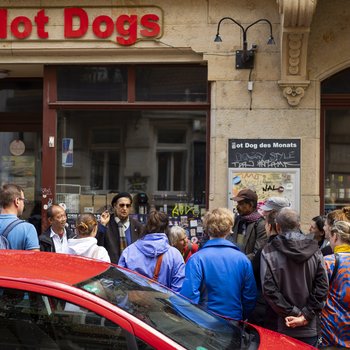I want to know how people live, and how they used to live. How they make their lives meaningful, and above all, what they make with their hands. That’s what brought me to my course of studies and, in some ways, also to my field of work as an ethnologist and an expert in religious and Ethiopian studies. It was not only in Ethiopia that I explored the realities of life, but also right on my doorstep in Dresden; in Saxony - I am discovering how many links exist between the various cultures in Saxony.
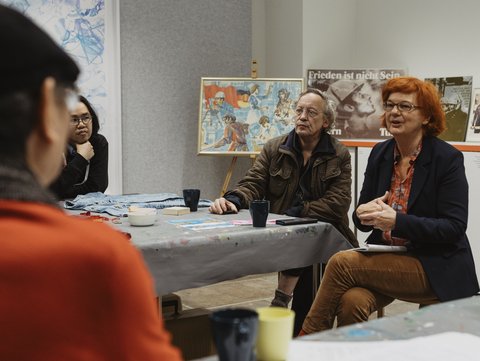
Workshop mit Zeitzeug*innen “Jeans nach Dienstschluss” mit Hung Cao The und Van Ngoc Pham
© Staatliche Kunstsammlungen Dresden, Foto: Iona Dutz
I launched biographical storytelling projects in collaboration with the association Kultur Aktiv e. V., always in combination with art and handicrafts. The exhibition in the Albertinum, “Revolutionary Romances? Global Art Histories in the GDR”, showed how art and politics influence one another. It looked back at times that are in the past, yet very much present. We designed our supporting events to search for an answer to the question, “How did art create connections between the cultures?” How did “foreigners” live here in the GDR era?
I found various people who lived through those times and joined young artists in tracing the past. We explored mail art with Marí Bohley and Julia Eberth, and learned about screen printing as a political art form with Moussa Mbarek. Furthermore, the needlework of Vietnamese contract workers was relevant, taking blue cotton and turning it into legwear – much-coveted jeans. Were they all trained tailors? No. They trusted in their hands and their manual skills. Just like Mexican-born Bela Álvarez, whose art, you could say, weaves a new history. She instructs participants to embroider photographs taken during the GDR era. One woman from Chile, Montserrat Butter, gives an eyewitness account of her flight to the GDR.
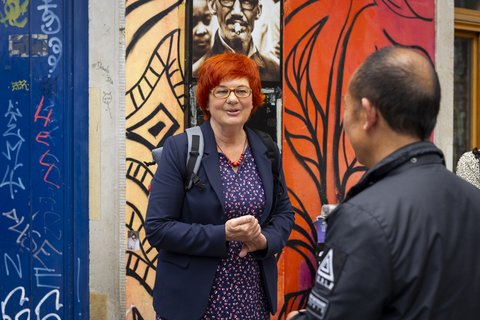
Stadtspaziergang “Die Neustadt zwischen Hanoi und Havanna” mit Hung Cao The, Bui Truong Binh und Dr. Hussein Jinah
© Staatliche Kunstsammlungen Dresden, Foto: Nora Börding
Many different cultures came together in the workshops at the Albertinum. Art was created and stories were retold. And we discovered global perspectives outside the Albertinum, too, on walking tours exploring the Altstadt with Janina Kracht, and the Neustadt with Hung Cao The. As I am still curious about the biographies behind Saxony’s cultural diversity, I have decided to simply carry on.

Weiter Lesen
On 13 October 2022, the Albertinum of the Staatliche Kunstsammlungen Dresden hosted the conference “Revolutionary Romances: Into the Cold – Alternative Artistic Trajectories into (Post-)Communist Europe.” A report by Julia Tatiana Bailey and Christopher Williams-Wynn.
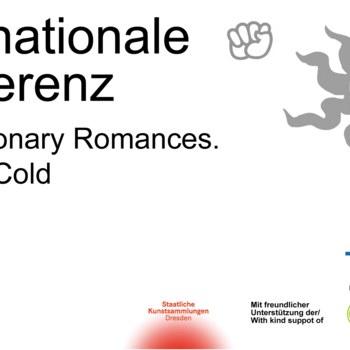
The "ostZONE" series, part of the special exhibition "Revolutionary Romances? Global Art Histories in the GDR", created a space within the Albertinum for anyone to share conversations, questions, and memories of life in the GDR and in modern-day eastern Germany. Read about Hung The Cao and his workshop with contemporaries "Jeans nach Dienstschluss" ("Jeans after Hours").
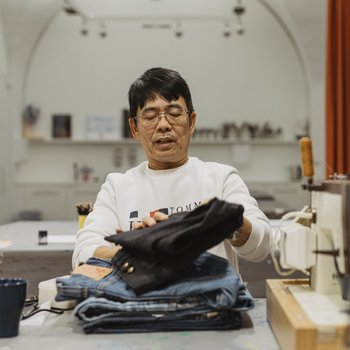
The "ostZONE" series, part of the special exhibition "Revolutionary Romances? Global Art Histories in the GDR", created a space within the Albertinum for anyone to share conversations, questions, and memories of life in the GDR and in modern-day eastern Germany. During the city walk through the Neustadt “The Neustadt between Hanoi and Havana”, Dr. Hussein Jinah invited participants into the Spätshop where he works and told them about his history and his goals: To promote peace, cohesion and non-violence in society.
